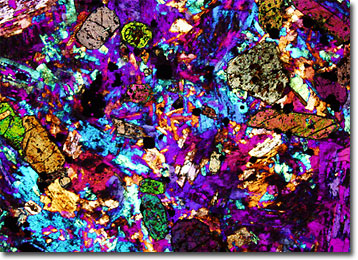Polarized Light Microscopy Digital Image Gallery
Alkalic Syenite
Coined by the early Roman scholar Pliny the Elder, the term syenite was originally used to designate rocks that looked similar to the hornblendic granite found in Syene, Egypt, which was widely used in ancient times for construction. However, today the word is generally utilized to refer to any of a class of intrusive igneous rocks primarily composed of alkali feldspar and a ferromagnesian mineral.

Though uncommon, notable occurrences of syenite can be found in Germany and the United States. Indeed, these sizable deposits are sometimes quarried for use as building stones. As noted by Pliny the Elder, the texture of syenites is the same as that of granites, the primary difference between the two being only the amount of quartz they contain. Syenites are often distinguished from one another based upon their constituent ferromagnesian mineral. They may also, however, be classified by the type of alkali feldspar they contain.
Alkalic, or alkali, syenites are a special group of rocks that are differentiated from other syenites by the fact that they contain a feldspathoid mineral, such as sodalite, leucite, or nepheline. They also contain significantly less quartz than other syenites. Relatively rare on a global scale, one of the best examples of an alkalic syenite can be found at Mont St. Hilaire in Quebec, Canada. The most studied alkalic syenite is nephelinesyenite, which is remarkable for its extensive variation in mineralogy, habit, and appearance. This unusual rock is occasionally utilized in the production of glass and ceramics.
